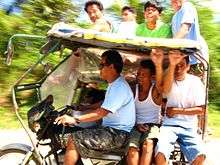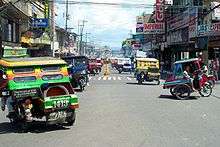Motorized tricycle (Philippines)


Motorized tricycles, or simply tricycles, are an indigenous form of the auto rickshaw and are a common means of public or private transportation in the Philippines. These public utility vehicles either ply a set route or are for-hire, like taxis. The Boracay Budget Travel website says of the motorized tricycle, "The tricycle is the most popular means of transport in small towns and cities, especially in the rural areas."[1]
Tricycles are built in a variety of styles, which differ from city to city, and are usually made locally by building a sidecar and affixing it to an imported motorcycle. Usually both the cycle and sidecar are covered, but not always by the same roof. Larger companies, such as Fitcor Marketing, also manufacture passenger tricycles.[2] They are built with more seats with the motor situated at the back, rather than below the driver as per a motorcycle.
Passenger tricycles
Passenger tricycles can accommodate from four passengers up to as many as 6 or more, excluding the driver.[3] Goods can be placed on the roof. One or two passengers can sit behind the driver while several more can sit in the sidecar, depending upon the design. Additional passengers can sit on the roof or stand hanging onto the side or back of the sidecar. In rainy weather, a tricycle will be completely enclosed in heavy plastic covering.
Tricycles can be painted colorfully, like jeepneys.
Fares are less than taxi fares (if the city or municipality has taxis), yet more expensive than jeepney fares. Fares range from P6 to P250, depending on the locality and the distance to be ridden. Inside cities, tricycles often operate as shared taxis, where passenger fares are calculated per passenger and after the distance traveled. These fares are close to the fares of jeepneys. For longer journeys or in areas with heavy tourism, the driver will usually request that the passenger hire the whole tricycle and negotiate a "special fare", which will then be a private hire.[2]
Many tricycles are now being replaced with a local version of Tuk-tuks which has superior engines and seating space. While technically not a tricycle as its private versions are not forbidden in national roads, they are treated as advanced versions of tricycles and deployed as such.
Motorela
The Motorela, locally nicknamed as "the mini jeepney", is a variant of a motorized tricycle used in Northern Mindanao, particularly in Cagayan de Oro City and Bukidnon province. It is a motorcycle with an enclosed cabin rigidly attached, and has four wheels - the two wheels of a motorcycle, and an additional wheel on each side. It has the capacity to carry more passengers than the traditional tricycle. The motorela was invented by Raphael Floirendo, a mechanic from Cagayan de Oro, in 1964.[4][5] Motorela comes from the words “motorized” and “caritela”.[6]
Cargo tricycles
Cargo tricycles are also used in the Philippines and elsewhere in Asia. The cargo tricycle either has a bed in the back or on the side as a sidecar.[7]
External links
![]()
References
- ↑ Boracay Budget Travel website, "Archived copy". Archived from the original on 2012-06-30. Retrieved 2013-04-27. ; William C. Pollard, Jr., email to Lonely Planet, November 1, 2010, p. 2.
- 1 2 Greg Bloom; Michael Grosberg; Virginia Jealous; Piers Kelly (May 2009). Philippines. Lonely Planet. p. 450. ISBN 978-1741047219.
- ↑ "Tricycles in Sorsogon". Sorsogoncity.wordpress.com. 2011-07-11. Retrieved 2015-11-11.
- ↑ "Tricycle, Motorela & Habal-Habal". Silent Garden. 2015. Retrieved 2015-11-11.
- ↑ "Cagayan de Oro Transportation". cdoguide. 2009-01-26. Retrieved 2015-11-11.
- ↑ "Raphael Floirendo – the Motorela Inventor". www.CDODev.Com. 2010-03-18. Retrieved 2015-11-11.
- ↑ Alibaba.com website.